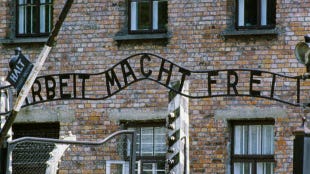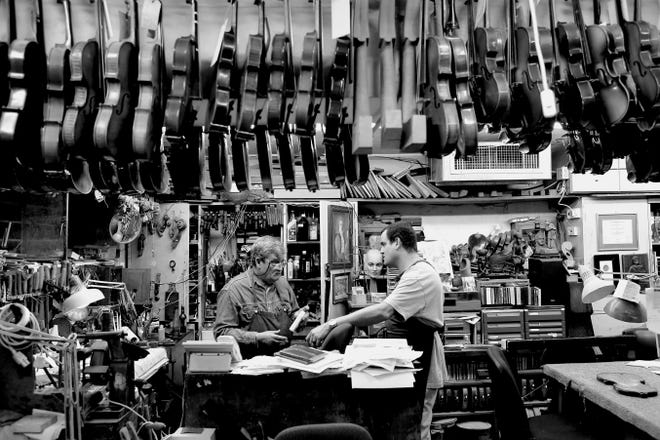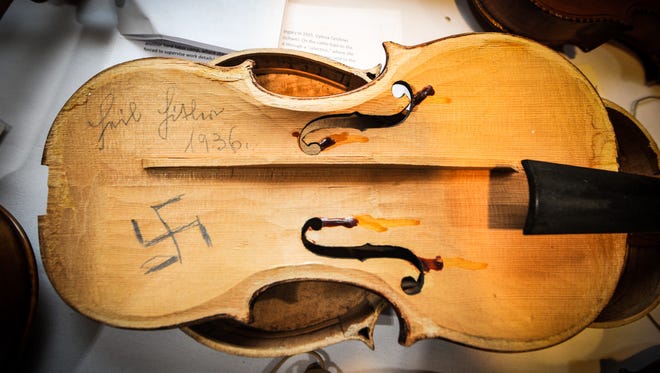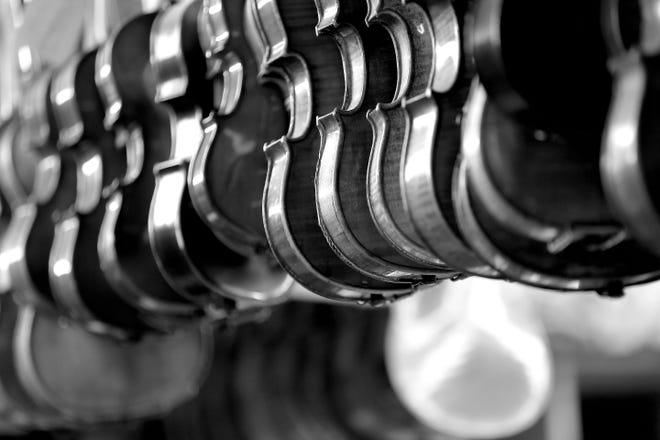Why Didn t Jews From the Concentration Camps Continue to Play Violin After War
Violins that survived the Holocaust — even when their owners did not — will be exhibited and played in Knoxville in January.
Forty-seven violins played by Jewish musicians during the Holocaust will come to Tennessee. Thirty-seven will be displayed Jan. 4-27 in a free "Violins of Hope: Strings of the Holocaust" exhibit at the University of Tennessee Downtown Gallery, 106 S. Gay St.
Six million Jews were killed during World War II in the Nazi regime's campaign to eradicate Europe's Jewish community.
Some of the restored violins will be played by Knoxville Symphony Orchestra musicians in 7 p.m. Jan. 23 and Jan. 24 concerts at the Tennessee Theatre, 604. S Gay. St.
Tickets are $40, $70, $90 or $150 at violinsofhopeknox.com. University of Tennessee's Clarence Brown Theatre performances and narration by Knoxville media personality Hallerin Hilton Hill are part of the concerts.
The concerts raise money for event organizer, the Stanford Eisenberg Knoxville Jewish Day School. The musical performances — as well as the exhibit — incorporate themes "of resilience, of hope, of injustice, of survival," said Miriam Esther Wilhelm, head of the school. "And hopefully an appreciation for diversity, tolerance, social justice and acceptance."

Victory, remembrance in music
Tel Aviv violin maker/restorer Amnon Weinstein found and restored the often worn, damaged or forgotten instruments in the past two decades. Weinstein's Violins of Hope project continues to find and restore Holocaust violins; the collection also includes one viola and one cello.
Weinstein's parents Moshe and Golda Weinstein escaped from Europe to Palestine in 1938. But 400 of their relatives died in the Holocaust. Amnon Weinstein has dedicated his Violins of Hope work to the relatives he never knew.
Weinstein has said the violins represent a victory each time they're played in concert.
"The message for all is simple. Never again, never again," he said in an announcement about the Knoxville event.

It was the violin of an unnamed Auschwitz survivor that influenced Weinstein to later save the instruments and preserve their stories. Author and University of North Carolina at Charlotte professor James A. Grymes tells that story in his 2014 book, "Violins of Hope: Instruments of Hope and Liberation in Mankind's Darkest Hour."
It was the late 1980s when the man, whose name Weinstein doesn't remember, brought his violin to be repaired. He hadn't touched the instrument, damaged from being played in rain and snow, since he'd left Auschwitz. The death camp created a prisoner orchestra; inmates were often ordered to play music as other prisoners were sent to gas chambers.
The man asked Weinstein to restore the violin so he could give it to his grandson. Weinstein took the violin apart to repair it. Inside, he found ashes. He could only assume the ashes once filtered into the instrument from the Auschwitz crematorium.
That, Grymes wrote, shook the violin maker "to his core but he quickly pushed those gruesome thoughts aside. It was still too difficult for him to think about the Holocaust."

Violins of Hope
By the 1990s Weinstein decided to find and restore violins from the Holocaust. Violins of Hope first came to America in 2012 and has toured cities that include Washington D.C., Cleveland, Ohio and Nashville. From Knoxville, the violins go to Phoenix.
Some of the violins once belonged to Holocaust survivors who after the war refused to play German-made instruments. Some, buried to hide them from Nazis or forgotten in attics for decades, were battered and damaged before Weinstein's months of restoration.
Some instruments, like the one Weinstein repaired for the man who survived Auschwitz, were played by musicians in the concentration camps. Others were passed through families who donated them to Violins of Hope.
Surviving with, without music
Some violins are survival stories. Nazi work camp prisoner Sandor Fisher was ordered to play music for German officers as they dined. When his captors finished, Fisher smuggled leftover food to friends.
Feivel Wininger survived life in a Ukrainian ghetto by playing his violin. Wininger performed at weddings or holidays, earning food he shared with 17 family members or friends.
Before Heinrich Herrmann was sent to a concentration camp he entrusted his 150-year-old violin to a friend. Afraid he'd be arrested for having Jewish property, Herrmann's friend buried the violin in his garden.
Herrmann and his violin survived. The badly damaged instrument was dug up, returned to Herrmann and restored. He played it another four decades.

One instrument in the "Violins of Hope" exhibit will never be restored. Sometime in 1936 a Jewish man took his violin for a simple repair. But the repairman opened the instrument and inside inscribed "Heil Hitler, 1936" and a swastika.
No one knew of the inscription until a Washington, D.C. violin-maker bought the instrument decades later.

A message in the music
Other violins are memorials to lives lost, potential destroyed and music stopped. Among them is one an unnamed man tossed from a cattle train going to a concentration camp in 1942.
The story's told that the man yelled, "In the place where I'm going now, I don't need a violin. Here, take my violin so it may live!" Picked up by a French railroad worker and abandoned in an attic for decades, the violin eventually was given to Violins of Hope.
Fanny Hecht was trying to flee the Nazis when she asked neighbor Helen Visser to care for her violin until she returned. Hecht never came back. Seventy years later Visser's grandchildren learned the Hecht family died in concentration camps. They gave the Hecht violin to Weinstein.
"One of the atrocities of the Holocaust is that it is hard for people to fathom. When you talk about six million people being killed — I can't even picture that," Wilhelm said. "But when you talk about a child being torn away from his mother or when you talk about a violinist playing a violin, you personalize the stories.
"That's when you can relate to them and that's when we can bring the message into our lives," she said. "Are we standing up (against) bigotry and hatred and racism the way we should?"
"When you hear this music, on one hand, there's real sadness. You feel for the loss of the people who didn't get to play it, for the years they were silenced," said Wilhelm, the granddaughter of Holocaust survivors.
"But there's also a real triumph in that the violins are playing again. And I think that's the beauty of the Jewish people, the beauty of humanity, how they can pull back and not be defeated and keep trying."
Source: https://www.knoxnews.com/story/life/2018/12/23/holocaust-victims-violins-hope-jewish-world-war-ii-auschwitz-concentration-camp-isreal-nazi-germany/2259685002/
0 Response to "Why Didn t Jews From the Concentration Camps Continue to Play Violin After War"
Post a Comment